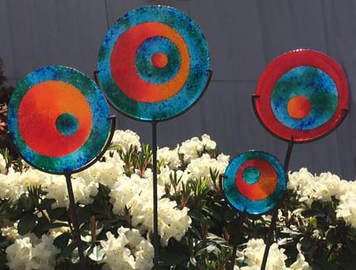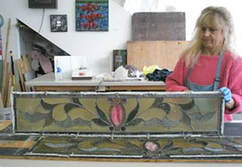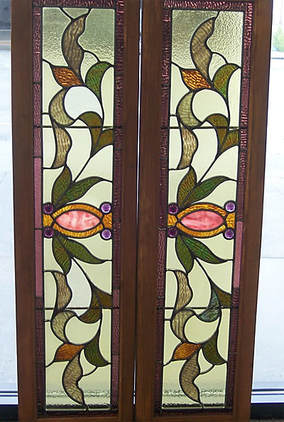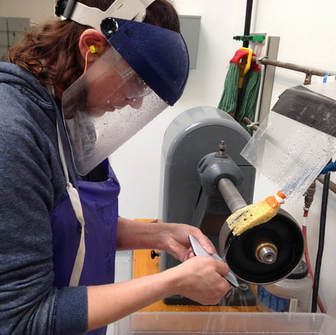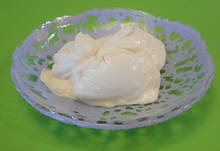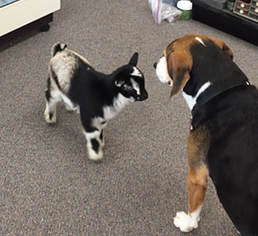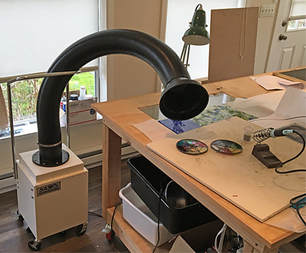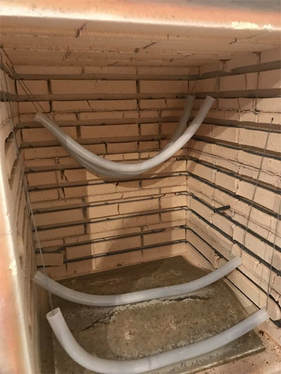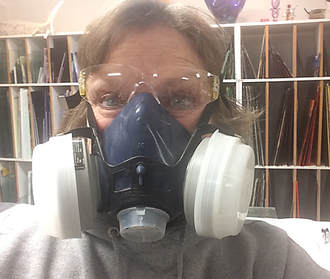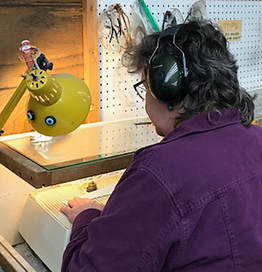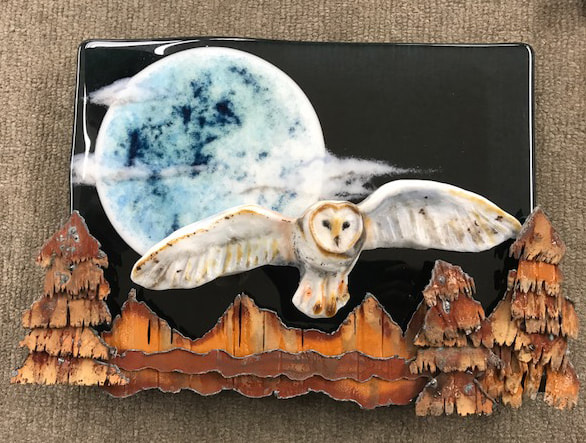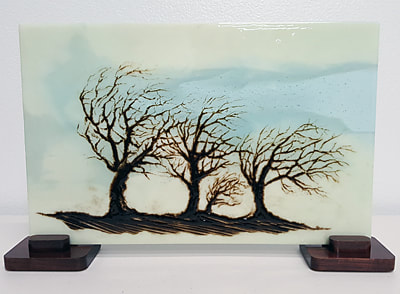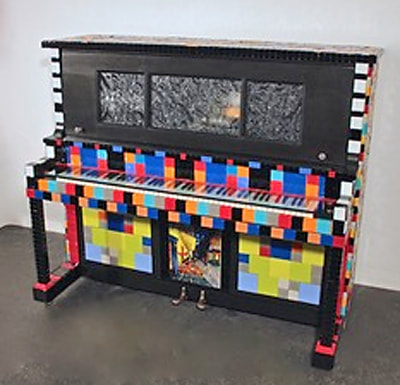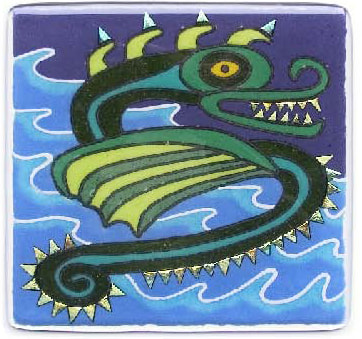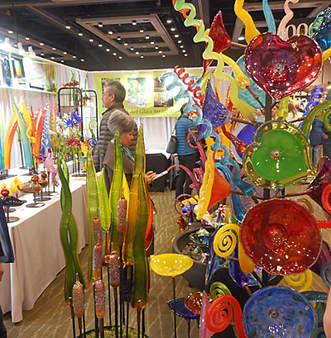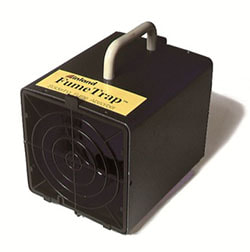Newsletter: Winter 2018
|
With this issue we start our second year. Thanks to all who have contributed news, images, and discounts. Have a glassy new year!
Safe with Glass
|
We've probably all cut ourselves at least once while sweeping up broken glass. On the other hand glass is so stable that EPA cleanups encase hazardous materials in glass to keep them out of the environment. If you can keep it from breaking, your glass art is very safe (scroll down for tips on staying safe in the studio).
Safe Glass Art Care
1) Don't change temperature fast. Most glass art is "soda-lime" (also called "soft glass") rather than the more expensive "boro-silicate" (like your freezer-to-oven brand-named glassware). To make more than a 50° F temperature change, do it slowly or risk breakage:
Other temperature issues: freeze/thaw can break glass art outdoors if it collects water
You can see Bedrock Industries' lollipops like these and other glass garden art at the NW Flower and Garden Show in Seattle Feb 7-11
|
2) Don't over stress your glass. Unlike the windows in your car, your glass art is probably not tempered or laminated so it needs to be thicker to withstand a lot of weight or pressure. i.e. if it isn't designed as bench, don't sit on it. If it isn't designed as a hammer, don't pound with it...
3) Store/hang your glass properly
Even if vertical, metal frames tend to sag with time and the glass can break. Store windows upright (rather than flat in a cardboard box as happened to the ones in the before photo). Having a wooden frame will also make your windows more durable.
The lead in leaded windows and lamps is safe if not disturbed. It does not flake off like paint or pose a health risk in normal use, especially with a patina or wax coating on it. That said, you do want to take care when cleaning: use mild dish soap rather than a commercial window cleaner (these often have ammonia, vinegar or other non-neutral pH components). Stronger chemicals can cause a chemical reaction and degrade the stability of the window. While you are cleaning notice any break in the joints, powder in the caulking or decay in the wooden sash. If these issues are not attended to while they are small, the window will eventually disintegrate. Consult your local stained glass studio if you can't figure out how to fix it yourself. If you need to dispose of a broken window take the lead to your local non-ferrous metal recycler or hazmat site. The wrapped glass should be safe in the garbage.
|
Make Your Art Safe
|
The Bullseye Glass Resource Center teaches how to use coldworking equipment safely March 3-4 in Portland OR.
|
Is it safe for food? For ordinary clear glass, definitely yes. The primary risk with some art glass is metal ions, like lead or cadmium which are used to increase brilliance or color in the glass, leaching into acidic foods. Such leaching takes a very, very long time at normal temperatures and pressures. Even old lead crystal decanters and glasses are considered safe for occasional use, but not recommended for long-term storage of acidic liquids like wine.
The Bullseye Glass Company has had lots of testing done and their findings imply that in general, if capped with clear glass and created by normal fusing processes, even glass colored with toxic metals like lead and cadmium should be safe for occasional food use. However, because artists' processes vary, no one can assure you that a specific piece of glass art is food safe without having that piece tested. Getting the piece back from the lab intact is uncertain so expecting such testing on one-of-a-kind glass art is generally unreasonable. If the artist stammers when you ask "is it food safe", you now know why.
|
|
Studio Safety
This isn't just about you: you don't want your child or pet crawling around in glass dust or your studio-mate getting treated for heavy metal poisoning. The safety pages at Bullseye Glass, King County, and Gregory Glass are recommended reading. These and many friends have all been helpful in generating the tips below. If you live in King County WA you can even request a studio visit and maybe even get financial help in making your studio safer (the studio fume extractor shown below was the result of this program). If anyone knows of similar programs in their county, please post them to our moderated Facebook page. |
Keep your studio visitors safe as well as yourself (Mattie and Violet visit Glass Expressions).
|
|
GENERAL
|
Bridget Culligan's Sentry Air Systems fume extractor helps keep soldering fumes from filling her studio while she restores a customer's glass kaleidoscope.
|
|
Yes, those are melted quartz tubes. Even if you do everything right, things happen.
|
|
EYES
|
Debbie Patana will be wearing the proper gear for dealing with powdered glass when Inspirations hosts Warren Norgard's mandela making class in Chinook WA this March.
|
|
EARS
|
Glass Expressions advises using hearing protection when at the grinder
|
|
BODY:
|
Relevant videos from humorist Anthony Scala for a lighter take:
An idiot's guide to coldworking An idiot's guide to glass blowing NEXT ISSUE: "Glass Tips and Tricks". Get your 15 seconds of fame and help everyone make better glass by sending us images of your favorite glass tips and tricks.
FriendsInGlass (you know what) gmail.com We've simplified the Classes/Resources page. If you offer classes (or want to help someone who does) please see if I have you listed/linked correctly. If you have a specific class coming up please post it to our moderated Facebook page.
|
Karen Seymour, Editor
What's New?
|
Fred Buxton's "Windswept" fused landscape (yes, he teaches classes)
|
Gina Mitchel's Piano Bar opens up to store bottles, glasses etc. (Reception for her show at the Bayview Cash Store, Langly WA is March 10, 5:30 to 7pm)
|
How'd They Do That?Richard LaLonde has been making colorful glass and teaching his liquid glass line technique for many years. He offers a detailed explanation plus CMC goop instructions on his website. Better yet, take a workshop or buy one of his books. He cautions you to be sure to wear a proper dust mask (NIOSH 90) for frit work.
|
(mouse-over the image to play it)
|
Announcements & Events
Now until April 8: Bellevue Arts Museum, Bellevue WA
Making Our Mark, art by Pratt teaching artists Jan 20 Whidbey Glass Artists Meet and Greet, LaLonde Studio, Freeland WA (email Gina Michel at 1shopcat (add symbol) gmail.com for details) Feb. 7-11 NW Flower and Garden Show, Seattle WA Feb. 12 Artists application deadline for Schack Juried show, Everett WA (Show is March 8 - April 14) Feb. 13-17 Bullseye Glass Resource Center winter sale Portland OR Feb. 23 Artists application deadline for Bulleye Emerge, Portland OR (Show starts June 23rd) Feb. 26 Artists application deadline Bellevue Arts Museum Biennial, WA (Show starts Nov. 9th) March 24-25 Best of the NW, Seattle WA |
Island Art Glass will be at both the NW Flower and Garden Show and The Best of the NW in Seattle. Go to either or both shows and see lots of great glass.
|
Your favorite glassy event isn't here? Send us a note or post it to our moderated Facebook page.
You sell/teach glass art and you're not in our Gallery? It's free. Without you and your other glass friends our database isn't nearly as useful to the the Pacific NW glass community. We want a photo of yourself at work for the artist directory and 3 images of your art for the gallery plus a bit more info. so prospective buyers, galleries, students etc. can contact you.
FriendsInGlass (you know the symbol) gmail.com or (206) 525-1577
Thanks!
Karen Seymour
FriendsInGlass (you know the symbol) gmail.com or (206) 525-1577
Thanks!
Karen Seymour
|
Friends In Glass Winter 2018 Coupon
Expires February 28, 2018 Safe With Glass: 10% off * of full retail price on named items from any of these participating organizations NOT VALID WITHOUT SUBSCRIBER CODE
NW Art Glass, Redmond WA: 10% off safety-related items
Bullseye Glass Resource Center, Portland OR (only): 10% off introductory classes HIS Glassworks, Asheville, NC: 10% off safety-related items (Diamond Life aprons excluded) Seattle Pottery Supply, Seattle WA, 10% off electric kiln heating elements Western Safety Products, Seattle WA, 10% off safety gear |
Fume Trap™ at NW Art Glass
|
*The fine print: Coupon can be used only once with any given organization/artist. One size can’t possibly fit all: due to contracts, special agreements etc. the participating organization/artist reserves the right to exempt any particular item from the coupon. Please inquire before attempting to redeem the coupon. Coupon is not transferable, can not be combined with any other discount and has no monetary value.
Want a bit of free publicity? Consider supporting our efforts by offering our subscribers a 10% discount in a future issue.
Thank you to all those who have done so!
Want a bit of free publicity? Consider supporting our efforts by offering our subscribers a 10% discount in a future issue.
Thank you to all those who have done so!
Copyright Friends In Glass 2018 -- All Images are used by permission and those copyrights are retained by the artists
